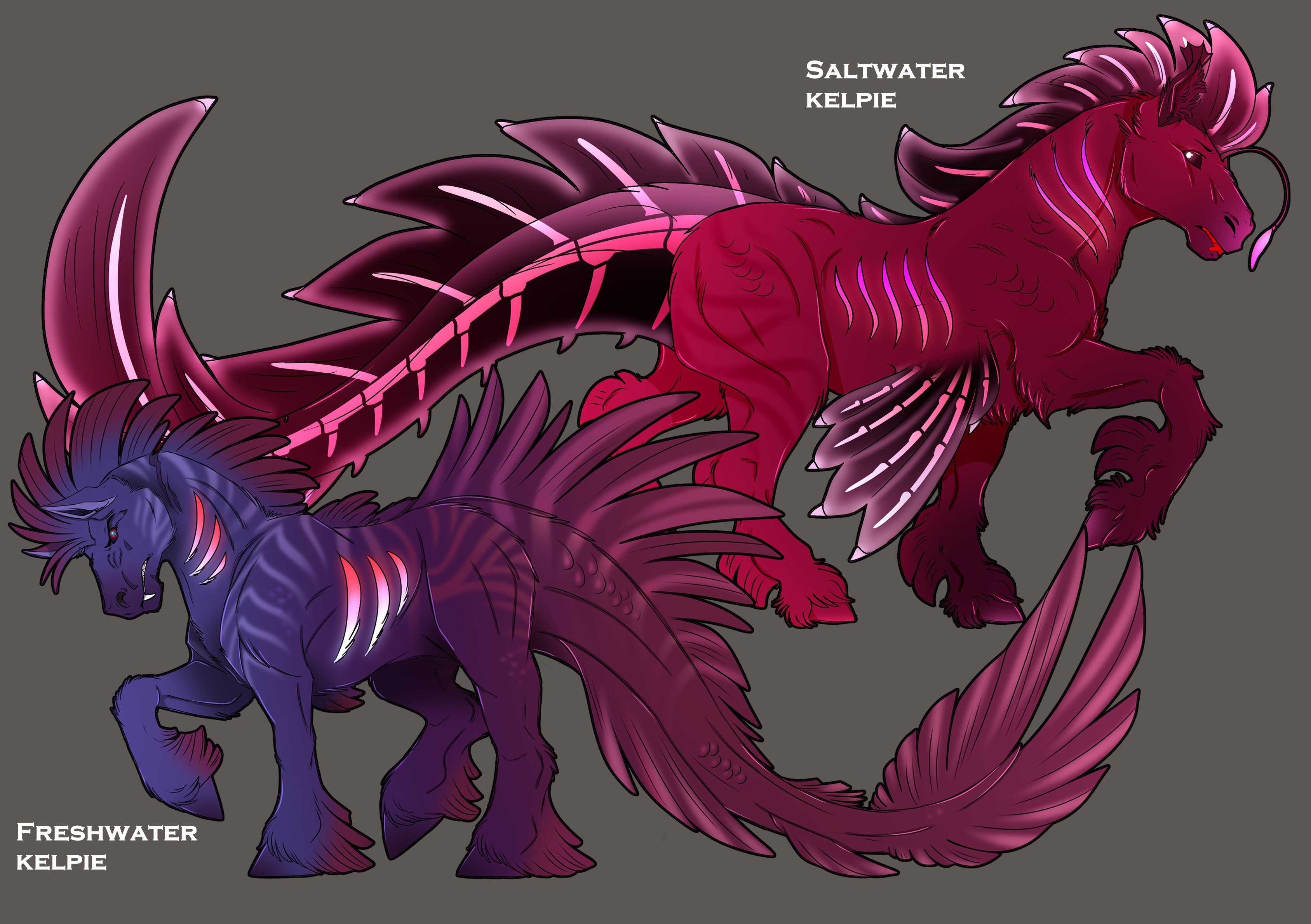Abyssal forms, also called "true colors" or "the other form" by kelpies, are the alternative appearances taken by Freshwater kelpies and Saltwater kelpies. Other species know less about these due to not witnessing them often but are as essential and useful to the kelpies nonetheless.
Abyssal forms completely change the colors of a kelpie - these colors are random, and have nothing to do with their species or gender. They get longer fish-like tails and various new fins of diverse shapes. Their bodies are covered in a mix of fish-like scales and fur. The eyes' sclera gets very dark, and the gills they earn are located on their neck, flanks, and sometimes tail. The gills are bioluminescent and the light intensity goes along with their respiration.
The main difference between freshwaters and saltwaters, apart from the size, is that saltwater have multiple see-through parts on their tail and fins, showing their bones inside. They also have a little lantern-like appendage on their forehead, similar to anglerfish, as well as little fins on their ears (a trait that can be observed on freshwaters too, but all saltwaters do have it). Saltwaters also have a lot more bioluminescence on their bodies.
Kelpies can mostly be seen in their terrestrial forms, in which they are still able to swim very well. However, they can shift to their abyssal forms, which are much more fish-like and designed for the water. Fins and fish-tails improve the kelpie's mobility underwater and allow them to be faster. The bioluminescence of their gills and some markings are known to be a way for kelpies to communicate with each other as some kind of body language.
Their underwater vision and smell are improved, and of course, their respiratory system is entirely dedicated to breathing underwater, therefore a kelpie in their abyssal form can't breathe the surface's air. They also become more adapted to the various levels of pressure of the water environments.
The shapeshifting is automatically triggered when needed, but it is known that kelpies can use it at will too. Two situations will trigger the shifting : When a kelpie stays in the water for too long. Prolonged contact with the water will make a kelpie take its abyssal form, as it is more comfortable for them to evolve underwater in this appearance. When a kelpie encounters a certain level of pressure. Their body immediately shifts to the abyssal form to help them descend into the abysses and deep waters.
It takes some months for the foal to master it completely, making them vulnerable as they spend the first months of their lives underwater. Foals will discover the surface before the deep waters.
Saltwater kelpies are known to be able to dive deeper than freshwater kelpies, due to the fact they live in the ocean.
Description
_____________________________
Abyssal forms completely change the colors of a kelpie - these colors are random, and have nothing to do with their species or gender. They get longer fish-like tails and various new fins of diverse shapes. Their bodies are covered in a mix of fish-like scales and fur. The eyes' sclera gets very dark, and the gills they earn are located on their neck, flanks, and sometimes tail. The gills are bioluminescent and the light intensity goes along with their respiration.
The main difference between freshwaters and saltwaters, apart from the size, is that saltwater have multiple see-through parts on their tail and fins, showing their bones inside. They also have a little lantern-like appendage on their forehead, similar to anglerfish, as well as little fins on their ears (a trait that can be observed on freshwaters too, but all saltwaters do have it). Saltwaters also have a lot more bioluminescence on their bodies.
Lewis and Kiersten dancing, both freshwater kelpies
Utility of abyssal forms
_____________________________
Kelpies can mostly be seen in their terrestrial forms, in which they are still able to swim very well. However, they can shift to their abyssal forms, which are much more fish-like and designed for the water. Fins and fish-tails improve the kelpie's mobility underwater and allow them to be faster. The bioluminescence of their gills and some markings are known to be a way for kelpies to communicate with each other as some kind of body language.
Vasco (freshwater kelpie) showing his abyssal form
The shapeshifting is automatically triggered when needed, but it is known that kelpies can use it at will too. Two situations will trigger the shifting : When a kelpie stays in the water for too long. Prolonged contact with the water will make a kelpie take its abyssal form, as it is more comfortable for them to evolve underwater in this appearance. When a kelpie encounters a certain level of pressure. Their body immediately shifts to the abyssal form to help them descend into the abysses and deep waters.
It takes some months for the foal to master it completely, making them vulnerable as they spend the first months of their lives underwater. Foals will discover the surface before the deep waters.
Saltwater kelpies are known to be able to dive deeper than freshwater kelpies, due to the fact they live in the ocean.
